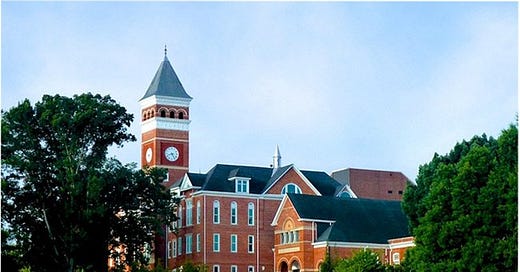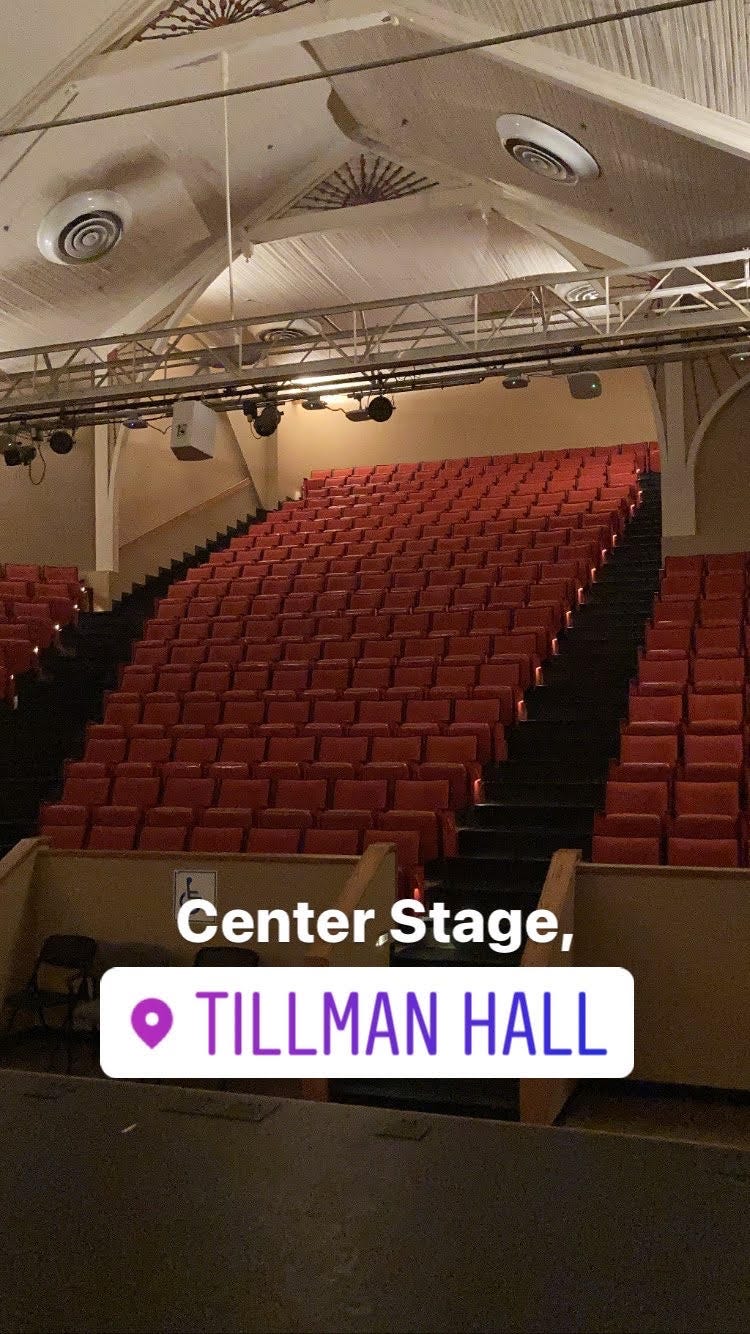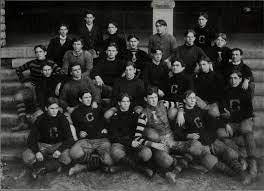Pitchfork Ben & The Curse of Hindsight
The Good, The Bad, and The Ugly of our Human plight.
I sent a photo, to a friend of mine, of my view from the center stage of Memorial Auditorium in Tillman Hall, up the steep rise of a thousand seats cascading up from my vantage point. As an alumni of the graduate school at Clemson and from my personal interactions, I thought they might like the “ah that’s neat” moment. Instead, I got a response along the lines of “that’s not called Tillman Hall, its called Old Main and I’ve never heard it called Tillman Hall…” Well then.
Luckily, “TILLMAN HALL” still spans the bell tower in big brass letters and never has it been called Old Main. More on that in a bit. In recent years, there’s been a push to remove the name, much like removing the Calhoun name from the Honors College.
The following write-up is one of personal reflection. The subject can be a bit touchy for some, but I think it’s worth exploring. While reading, please do so with an open mind and try to consider the different contradictory truths along the way.
The main building, the oldest and most iconic building, on Clemson’s campus is Tillman Hall. Tillman is a classic land grant school clocktower with bells inside and a late 19th century architecture and interior. You’ll find similar, albeit not as impossibly beautiful, buildings in Auburn, College Park, State College, and Baton Rouge. However, if you approached your favorite Nittany Lion (HTTLAIR) and asked them, they’d tell you their building was “Old Main” which is a colloquial term for The Main Building. So, why Tillman Hall?
In the annals of South Carolina™ history, there are several figures that lie on our path to Tillman Hall, in a literal historical timeline sense, and in a figurative sociological sense. The Lords Proprietors were the first to officially colonize the state and managed to do just well enough for it to survive until 1719, when The Boys™ set the stage for one Marion, Francis by rebelling against proprietary rule and inviting the crown to take over as a royal colony.
(Luckily, the writer’s family managed to survive the transatlantic passage and safely go ashore in 1680 in Charleston, before making their way, like so many Israelites before them, to the promised land up the coast in the Pee Dee Watershed.)
So you see, South Carolinians have long had a history of putting off the yoke of lordships and choosing instead to let a man’s natural talents float him to the top of the societal food chain. As with anything else, progress was slow. The state acted again in 1803, after a century of posh little lords bickering with each other, to build a unifying common denominator. The university of south carolina (sakerlina from here out) was founded as a means to bridge the gap between the rice lords of the lowcountry and the cotton barons of the upstate. This amicable move was nice, as long as you met a certain arbitrary social qualification. But as South Carolina progressed - at about the pace of the clearing of a cypress swamp for rice fields - into the modern era, the everyman itched for a little better seat at the table.
Enter Thomas Green Clemson®
TGC was an interesting fellow. Truly a 19th century Renaissance Man that I personally think is an outstanding example of the well rounded citizen that is crucial to a flourishing society. He came from a mixed episcopalian-quaker background and as a result not much of his religious experience is documented as a major guide to his life. In 1838, he married Anna Calhoun, daughter of the prominent - yet somehow becoming still more prominent - South Carolina Senator and US Vice President John C. Calhoun. He traveled to France and studied chemistry and metallurgy. He was appointed Ambassador to Belgium and upon his return settled in Maryland to study agriculture. In 1860 he was appointed US Superintendent of Agriculture and in 1863, at the age of 54, he enlisted to serve in the American Civil War, under the flag of South Carolina. He served in mines in Arkansas and Texas, creating nitrates for weapons and ordnance. In 1865, he was paroled and returned to his studies in Maryland until 1872, when he and his wife inherited Calhoun’s Fort Hill plantation outside of Pendleton, SC. After his death in 1888, his will bequeathed the Fort Hill property to the state for the establishment of a land grant institution known as Clemson Agricultural College of South Carolina. He did so in an attempt to prioritize agriculture and practical education because he felt the state did not appreciate the opportunities for the everyman that education in the agricultural and practical arts offered. Naturally, the powers-that-be took offense and scoffed at the idea of the everyman having access to education that could potentially lift them to prosperity. They would not willingly offer up some of the state’s resources to develop what they believed to be the subordinate class.
Enter Pitchfork Ben Tillman.
After the end of reconstruction in South Carolina in 1876 (kind of… different subject for a different time), Benjamin Tillman was involved in the managing of his farms, at which he was apparently keenly interested and adept, and the state’s political arena. After 6 years of politicking for the conservative leaders throughout the state, Tillman realized that the farmers and mill workers (that slow pace of progress catching up) were not being valued by the planter class in power. His direct experience, as a farmer himself, with the state’s economic system and crop lien program led him to believe change was needed. He sold land to pay of debts and founded a couple agricultural clubs that never got off the ground, but in 1885 he got his shot and he took it, speaking at a joint meeting of the Agricultural & Mechanical Society and Grange Society. He blamed the state’s politicians and lobbyists for implementing the system that was disproportionately affecting the most prominent social class in the state - the yeoman farmer. Shortly after, he was discussed as a candidate for governor as he continued to make touring speeches, taking jabs at his opponents and prying back the old political system so that the everyman might have his day.
It was during this period that cartoonists started portraying Tillman as a fiery speaker with his farmer’s pitchfork in hand, having his pokes at the opposition. Hence the name “Pitchfork Ben.”
Tillman met with Clemson in 1886 to discuss the establishment of an agricultural college. Clemson revealed his plans and named Tillman a lifetime trustee, one of seven. The board of trustees, made up of a majority lifetime appointments with each naming their own successor, meant that Clemson was not under direct control of the state and therefor could not be killed in its infancy by an unfriendly government. Clemson Agricultural College of South Carolina was legally founded in 1889. Tillman was elected Governor in 1890. The grounds and buildings were constructed and the first cadets reported in 1893.
The author’s favorite cadet, one Percy Adams George, reported in 1897 and was known to spend his time perfecting his skill at some useless form of American rugby on the parade grounds with some engineering professor overseeing the glorified mudwrestling.
Much to the chagrin of the posh little lords of the state, federal funds for agricultural education from the Morrill Land-Grant Colleges Act and the Hatch Act of 1887 were transferred from sakerlina to Clemson. A big no-no in the eyes of the ruling class. How would their precious sons every study philosophy, law, and the arts with money going to that upstart farm school? Farming isn’t important anyways, food just appears in the markets! Alas, another very lengthy post for another day.
The early days of Clemson were marked by engineering and agricultural focus. That inevitable progress, that has been chasing us down throughout the duration of this article, has finally arrived. The first graduates got degrees in mechanical-electrical engineering and agriculture. In the modern world of the 1890s, one had to know how to operate the machinery used to produce food, textiles, and infrastructure. Up through the great depression and the second world war, Clemson persevered under the watchful clocktower-eye of The Main Building. It wasn’t until 1946 that the iconic monolith was renamed Tillman Hall, in honor of the hero of that initial struggle.
So that’s the whole story, right?
I wish it were. The truth is, there’s more to this story. Heroes and villains never can be black and white.
Thomas Green Clemson.
Clemson served in the Confederate Army, in no small part because of who his father-in-law was. He was a plantation owner, and a slaveowner as well. Obviously, he had a lot to gain by maintaining the status quo and keeping in good relations with his wife’s family. Much like the brilliance of some of the founding fathers, Clemson presents a challenging duality. How could somebody so well versed in the sciences and arts be so accepting of the contradictions that surround him?
Luckily, in the postwar years, Clemson reflected and adamantly criticized the state and removed himself from the social and political organizations that had been the hotbed of secessionist sentiment. He was quick to see to the hiring of freedmen as day laborers on the Fort Hill property and continued his research in the agricultural sciences.
Even in his postwar criticisms of the antebellum structure that led to a devastating war, Clemson was unable to be something more. He could not remove himself from his background, his education, and his experiences. He was unable to be the man he may have been 100 years in the future. He hired day laborers, but contractually bound them in ways that left them little better off than slaves. He opposed the traditional power in the state, but did not explicitly invite progressive reform through his college. In fact, he structured it in such a way that the everyman, one peg down on the totem pole, was the only class that benefitted. Women, freedmen, and everybody else were not his goal. He aimed to enhance the experience of the class he believed held the key to economic prosperity for the state of South Carolina and chose to accept the plight of all others as an inconvenient necessity for his view of the ideal social structure.
Tillman was no better. In some ways, he was worse.
While he did not participate in the war, Tillman was an active member of the Redshirts, an organization designed to intimidate progressive voters during and after Reconstruction. He took pride in his brand of domestic violence against anybody that tried to challenge the traditional order, mostly freedmen. Of course, similar to Clemson, he eventually gained the mindset that the traditional order didn’t work, but the radically progressive order of the day was unacceptable. His efforts on behalf of the yeoman farmer were very vaguely associated with all walks of life. The upper middle class and the lower class alike benefitted from Pitchfork Ben’s rhetoric and prodding of the traditional powers. But never once would he stump for anybody of color. That was simply a bridge too far. Pitchfork Ben was a racist. As plain as day. His writings indicate as much and his actions are as damning as anything.
Now comes the hard part.
Can people do good things and bad things? Or do only good people do good things and only bad people do bad things? Or do good people become bad people as soon as they do a bad thing? Do a lifetime of good things get cancelled by a bad thing or is there a certain number of bad things that equate to a certain number of good things? This is the dilemma that we, as a society, face when looking backwards with the benefit of hindsight. We are all guilty of generalizing, certainly. Today, it seems that we are quick to deem somebody as good or bad based on one action, maybe the most recent, or maybe the most convenient for our stance at the time.
The Lords Proprietors did not care about the Vereens of the Santee, or the Georges of Gum Swamp. They set up their colonies to suit their interest in a way that they found acceptable. They made any compromises against their personal preference that they felt necessary to reach their priorities. Francis Marion probably wasn’t a huge fan of some of the men in his band of marauders. But I bet he saw the practicality in not being a horse’s ass about it. The lowcountry rice lords CERTAINLY did not see the upstate cotton barons as their equals, but they preferred to unify with a central capital city instead of potentially being divided by outside forces in the future. Every one of these actors experienced something that we all experience every day. They assessed the environment around them - where they came from, where they were, and what the future held - and made decisions. Decisions on how to act, decisions on what to create, and decisions on what was acceptable or not. Throughout human history, nobody has every acted in an unacceptable way. Think about it. If an act was unacceptable, it would be corrected and stopped. Otherwise, if it was not corrected, then it was - by definition - acceptable since it was accepted. For example, running the Carolina colony like your personal playground ended up being unacceptable, so the colonists told the Lords Proprietors to kick rocks.
In the Navy™ there is a saying “you rate what you skate” which means, if you get away with something you’re not supposed to do, then you can do it. Its human nature to push the boundaries of our limitations - both physical and social. If you’re over the age of 26, I bet you think twice before jumping off a 3 foot ledge that you would’ve dove headfirst from at 21. The same goes for our daily interactions. You can’t punch everybody that annoys you because YOUR society would deem it unacceptable (hopefully) and eventually would correct it. But in 1821, if you wanted to shoot a man for insulting your wife’s honor, THAT society probably didn’t think much of it. The key takeaway is that humans are constantly evolving. Not physically, but socially. Today’s unpalatable societal transgressions were yesterday’s progressive compromise.
Tillman was what he was. But in his time, he undoubtedly went through these same processes. He took stock of his culture, made an assessment on the past, present, and future of the society around him, and acted accordingly. And it was accepted! Had he lived in the 1930s, 1950s, 1990s, or today, he undoubtedly would have acted differently. The variables of his social equation would have been drastically different as that old friend of ours, progress, caught up.
The trick is not to try to erase the past or cast generalizations - of which we are all guilty - about the people therein, but to understand why the past occurred as it did and understand that those events have all played a small role in creating our present. A Counterfactual is a thought experiment you might encounter in economics. If Person A is only willing to pay $2 for apples, and person B is willing to pay $3, but person B is willing to pay $4 after we apply some treatment (such as higher income), does that mean person A would respond in the same way? If so, how do you define that same response? Is it a $1 increase or is it a 33% increase? The point is, we didn’t apply the treatment to person A and now the experiment is over. This is how a counterfactual works and we can apply a loose version of it to history. Would Tillman have taken all the steps he did, exactly as he took them, had he been a slightly different person? Marty McFly tells us messing with the past can be a little tricky for the present.
Obviously, I speak only from my own personal experience. What else can I do? None of us can understand the perspective of others. Sure, we can try, but never actually reach that understanding. The nuances of your experience that influence your perspective are so vast and so minute that another person can never see the same world you see. That is another one of our human plights. My blue is not your blue. Your cold is not mine.
As far as Tillman and Clemson are concerned, Tillman is essentially the Godfather. He undoubtedly had flaws. Who doesn’t? But if an institution like Clemson cannot honor a person to whom it owes so much - its very existence, what does that mean for the rest of us? Tillman Hall is not named in honor of the racism of Benjamin Tillman. Tillman Hall is named after the leadership and tenacity of the man who saw fit to provide opportunities to those that, before his actions, had none. That’s something worth honoring.
I think I’ve arrived on a sign-off. Feedback appreciated.
Your words are the rising tide that carries you into the sea of action.










